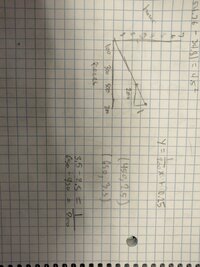Don't have any pictures but I remember some important details. John takes 2.5 hours to assemble 450 puzzle pieces and 3.5 hours to assemble 650 puzzle pieces. The growth is constant, create a linear equation with "y" as the amount of hours it takes and "x" as the amount of puzzle pieces. I need help with figuring out this equation.
You are using an out of date browser. It may not display this or other websites correctly.
You should upgrade or use an alternative browser.
You should upgrade or use an alternative browser.
A question bugging me: John takes 2.5 hours to assemble 450 puzzle pieces and 3.5 hours to assemble 650 puzzle pieces.
- Thread starter juh
- Start date
- Joined
- Feb 4, 2004
- Messages
- 16,583
You've been given two data points, (pieces, hours). You've been told that these points lie on a straight line. So apply the straight-line stuff you've learned (like finding slope) to determine the equation.Don't have any pictures but I remember some important details. John takes 2.5 hours to assemble 450 puzzle pieces and 3.5 hours to assemble 650 puzzle pieces. The growth is constant, create a linear equation with "y" as the amount of hours it takes and "x" as the amount of puzzle pieces. I need help with figuring out this equation.
If you get stuck, please reply with a clear listing of your thoughts and efforts so far. Thank you!
Eliz.
I realized this during my test and it confused me a lot but I guess it's just bad question design. Maybe it takes time to get the pieces out or something but if there are no pieces then this wouldn't make sense. This was a question on a state algebra 1 test.
Feels goodYou've been given two data points, (pieces, hours). You've been told that these points lie on a straight line. So apply the straight-line stuff you've learned (like finding slope) to determine the equation.
If you get stuck, please reply with a clear listing of your thoughts and efforts so far. Thank you!
El
Attachments
W
Look up in your text-book.
What is the equation of a line passing through (x1 , y1) and (x2 , y2) ?Don't have any pictures but I remember some important details. John takes 2.5 hours to assemble 450 puzzle pieces and 3.5 hours to assemble 650 puzzle pieces. The growth is constant, create a linear equation with "y" as the amount of hours it takes and "x" as the amount of puzzle pieces. I need help with figuring out this equation.
Look up in your text-book.
Steven G
Elite Member
- Joined
- Dec 30, 2014
- Messages
- 14,383
What you and @stapel are suggesting is the only way to do this problem just doesn't feel right. How can it take a non-zero (including negative values!) length of time to assemble a puzzle that has zero pieces?W
What is the equation of a line passing through (x1 , y1) and (x2 , y2) ?
Look up in your text-book.
A situation like this, imo, must be proportional (ie cross the origin) and this setup is not.
Last edited:
You could restrict the domain [250, 650]What you and @staple are suggesting is the only way to do this problem however it just doesn't feel right. How can it take a non-zero (including negative values!) length of time to assemble a puzzle that has zero pieces?
A situation like this, imo, must be proportional (ie cross the origin) and this setup is not.
Steven G
Elite Member
- Joined
- Dec 30, 2014
- Messages
- 14,383
Fine, but that doesn't eliminate the fact that the given points are not proportional.You could restrict the domain [250, 650]
Here is exactly what I am saying:
You can do a 450 piece puzzle in 2.5 hrs. That means that you can do 180 pieces in 1 hour. So in 3.5 hours you should be able to finish a 630 piece puzzle--Not a 650 piece puzzle.
I guess as time goes by one can do more pieces per hour but that is against this situation being linear as two helpers suggested and one of them is a very long time member.
Fine, but that doesn't eliminate the fact that the given points are not proportional.
Here is exactly what I am saying:
You can do a 450 piece puzzle in 2.5 hrs. That means that you can do 180 pieces in 1 hour. So in 3.5 hours you should be able to finish a 630 piece puzzle--Not a 650 piece puzzle.
I guess as time goes by one can do more pieces per hour but that is against this situation being linear as two helpers suggested and one of them is a very long time member.
It was 650 pieces I'm almost fully sure. Technically the math works but just not in a practical way. Probably just bad question design again. I'm like 98% sure on all the numbers in the question and that the growth rate is constant. Thanks for the help!

